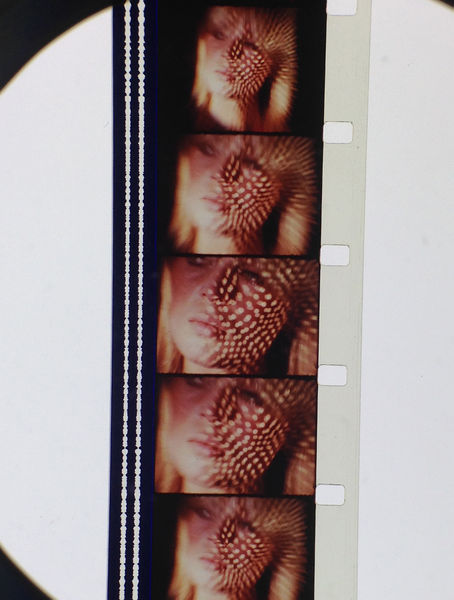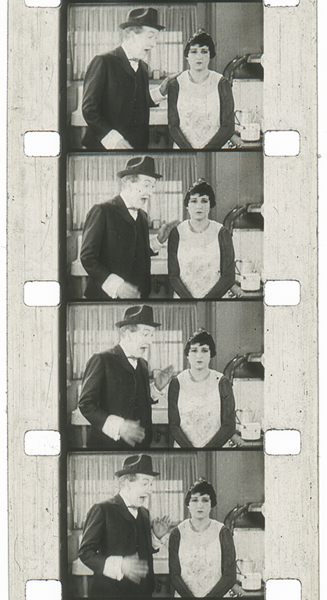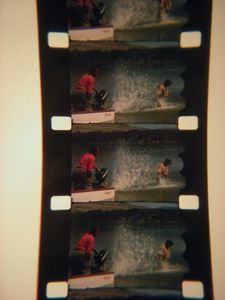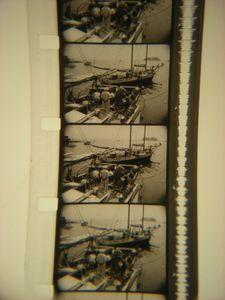| Welcome to Sprocket School! This project is maintained by volunteer editors. Learn more about how this works. |
16mm: Difference between revisions
No edit summary |
No edit summary |
||
| (8 intermediate revisions by 2 users not shown) | |||
| Line 1: | Line 1: | ||
<gallery widths=400px heights=400px mode=packed> | <gallery widths=400px heights=400px mode=packed> | ||
File:16mm film frames.JPG|A few frames from a 16mm print of ''Chelsea Girls''. | File:16mm film frames.JPG|A few frames from a 16mm print of ''Chelsea Girls''. | ||
File:16mm_test_film.jpg|16mm test film. | File:16mm_test_film.jpg|16mm [[test film]]. | ||
File:16mm Silent.png|Double-perf 16mm silent print. | |||
</gallery> | </gallery> | ||
| Line 10: | Line 11: | ||
*sound formats | *sound formats | ||
==16mm Aspect Ratios== | ==16mm Aspect Ratios== | ||
The [[16mm]] frame has a native full-frame aspect ratio of ~1.34:1. This is the aspect ratio of the vast majority of 16mm prints. | The [[16mm]] frame has a native full-frame aspect ratio of ~1.34:1. This is the aspect ratio of the vast majority of 16mm prints. 16mm was historically used for the distribution of Hollywood releases to nontheatrical venues (schools, prisons, summer camps, etc.) as well as for television broadcast. Further variations related to aspect ratio crop up on prints that were used for these purposes. These include simple cropping of widescreen or CinemaScope images to 16mm's native 1.33 as well as "[http://en.wikipedia.org/wiki/Pan_and_scan pan and scan]" efforts. | ||
Other 16mm aspect ratios exist, however. Some prints are hard-matted to widescreen aspect ratios like 1.85 and 1.66 (this is seen with some frequency on 16mm reductions of widescreen feature films originally released on 35mm). The same lens and plate is used for hard matted 16mm prints, you'll just see black on the top and bottom of the image on screen. | Other 16mm aspect ratios exist, however. Some prints are hard-matted to widescreen aspect ratios like 1.85 and 1.66 (this is seen with some frequency on 16mm reductions of widescreen feature films originally released on 35mm). The same lens and plate is used for hard matted 16mm prints, you'll just see black on the top and bottom of the image on screen. | ||
Anamorphic 16mm prints | ===Anamorphic 16mm prints=== | ||
These have an aspect ratio of 2.66:1 (because of the native 1.33 aspect ratio of the frame). Note that this means that anamorphic 16mm reductions of films originally released as 35mm anamorphic will be cropped slightly at the top and bottom of the frame! Proper projection of anamorphic 16mm prints require an anamorphic lens. | |||
| Line 24: | Line 26: | ||
File:16mm-scope2.jpg|''Anamorphic 16mm print'' | File:16mm-scope2.jpg|''Anamorphic 16mm print'' | ||
</gallery> | </gallery> | ||
==Sound Formats== | ==Sound Formats== | ||
[[File:Mauer track.JPG|left|thumb|200px|An example of a ''Mauer track''.]] | [[File:Mauer track.JPG|left|thumb|200px|An example of a ''Mauer track''.]] | ||
| Line 34: | Line 37: | ||
==Resources== | ==Resources== | ||
* [http://16mmdirectory.org/ 16mm Directory] | * [http://16mmdirectory.org/ 16mm Directory] | ||
*[http://www.paulivester.com/films/ 16mm film stock identification | * [http://www.paulivester.com/films/ 16mm film stock identification site from Paul Ivester ] | ||
* | * [http://www.brianpritchard.com/IMPF.htm Extensive 16mm film identification chart from Brian Pritchard] | ||
[[Category:Film prints]] | [[Category:Film prints]] | ||
[[Category:Film gauges]] | [[Category:Film gauges]] | ||
[[Category:16mm]] | |||
[[Category:Small gauge film]] | |||
Latest revision as of 13:06, 21 April 2020
-
A few frames from a 16mm print of Chelsea Girls.
-
16mm test film.
-
Double-perf 16mm silent print.
- aspect ratios (super 16, anamorphic prints)
- single perf or double perf
- emulsion in or out
- sound formats
16mm Aspect Ratios
The 16mm frame has a native full-frame aspect ratio of ~1.34:1. This is the aspect ratio of the vast majority of 16mm prints. 16mm was historically used for the distribution of Hollywood releases to nontheatrical venues (schools, prisons, summer camps, etc.) as well as for television broadcast. Further variations related to aspect ratio crop up on prints that were used for these purposes. These include simple cropping of widescreen or CinemaScope images to 16mm's native 1.33 as well as "pan and scan" efforts.
Other 16mm aspect ratios exist, however. Some prints are hard-matted to widescreen aspect ratios like 1.85 and 1.66 (this is seen with some frequency on 16mm reductions of widescreen feature films originally released on 35mm). The same lens and plate is used for hard matted 16mm prints, you'll just see black on the top and bottom of the image on screen.
Anamorphic 16mm prints
These have an aspect ratio of 2.66:1 (because of the native 1.33 aspect ratio of the frame). Note that this means that anamorphic 16mm reductions of films originally released as 35mm anamorphic will be cropped slightly at the top and bottom of the frame! Proper projection of anamorphic 16mm prints require an anamorphic lens.
-
Conventional full frame 16mm print without soundtrack
-
Conventional full frame 16mm print with soundtrack
-
Anamorphic 16mm print
Sound Formats

Related Articles
- 16mm projectors
- List of analog film exhibitors
- test films See 16mm test film





